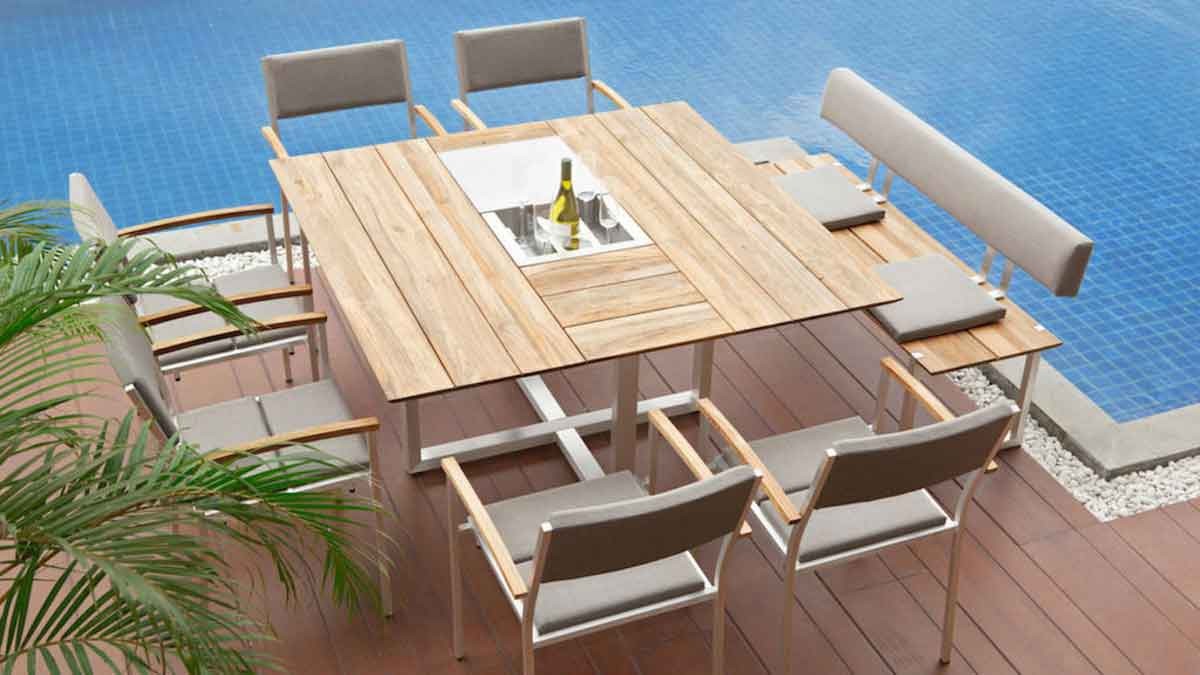Durable quality: weatherproof materials for outdoor furniture
28 Feb 2019

Furniture and accessories with UV and water-resistant textiles by Cane-line © Cane-line
Last summer has shown what effects climate change can have. Temperature and solar radiation increased in some regions of the world, while in others precipitation increased. Manufacturers of outdoor furniture are adapting to such climatic changes with particularly durable materials.
Today, the balcony, terrace and garden are naturally part of the living area and are designed accordingly – and not just in the private environment. Also in the hotel and gastronomy sector there is an increasing demand for homely design for the exterior. Sofas and upholstered armchairs, textiles or furniture for dining outdoors are in fashion and increase the comfort in the open air. But how can their surfaces be protected against weather phenomena such as strong UV radiation or large amounts of water?

Sustainable material mix of aluminum and recycled teak: greenline by Zebra © Zebra
A classic with a future: wood
In the face of climate change discussions, manufacturers, buyers and consumers are increasingly focusing on the resistant quality of outdoor furniture. As durable goods, they should be kept for a few years and equipped with appropriate materials. Traditionally, the natural material wood offers properties that are expected to last a long time. Teak or other timbers today often come from certified cultivation, are a renewable resource and can be easily recycled. Garden furniture made of wood, however, must be maintained regularly.

Manufactured with colourfast and non-deformable materials: Spyker collection by Gaber © Gaber
Durable plastics
The weatherproof classics for the outdoor sector also include plastics. For garden armchairs and sofas, especially poly rattan has conquered the market. The wickerwork made of synthetic fibers is easy to clean and, at least for the branded products, very UV resistant. Seat frames also use glass fiber reinforced polypropylene, which is also UV resistant and can be fully dyed and recycled. Newer plastics such as polymer concrete are permanently weather-resistant and very stable. The material allows furniture with an absolutely smooth and non-porous surface, which is particularly resistant to moisture, dirt and heat.

Durable and water-repellent: Ego recliner and LED Easy sunshade by Kettler © Kettler
Aluminum does not rust
In terms of weather resistance, aluminum furniture can also score. The light metal is extremely durable and does not rust. The durability of the material is also increased with coatings. Newer paint coatings for table plates have the aesthetic appeal of ceramic and prevent the heating of the metal.

The upholstery textile Patio is developed for outdoors with a resistent finish © Kvadrat
Fabric for sustainable comfort
The durability of textiles plays a decisive role in lying and seating furniture, cushion covers or parasols. Synthetic outdoor fabric today is easy to care for and extremely durable. Polyester brand fibers for covers, straps or cords meet even the highest demands. They are impervious to constant rain or high heat. Fabric made of these fibers is also skin-friendly, adapts to the body shapes and thus offers a pleasant sitting comfort. Even with regard to colourfulness and soft touch, resistant outdoor fabrics hardly differ from home textiles.
Current outdoor furniture often consists of a mix of materials: wood is combined with aluminum or stainless steel and textiles. This does not detract from its resistance and durability – on the contrary: garden furniture, which retains its quality even in extreme weather conditions, is created especially in the assembly of particularly resistant materials.
